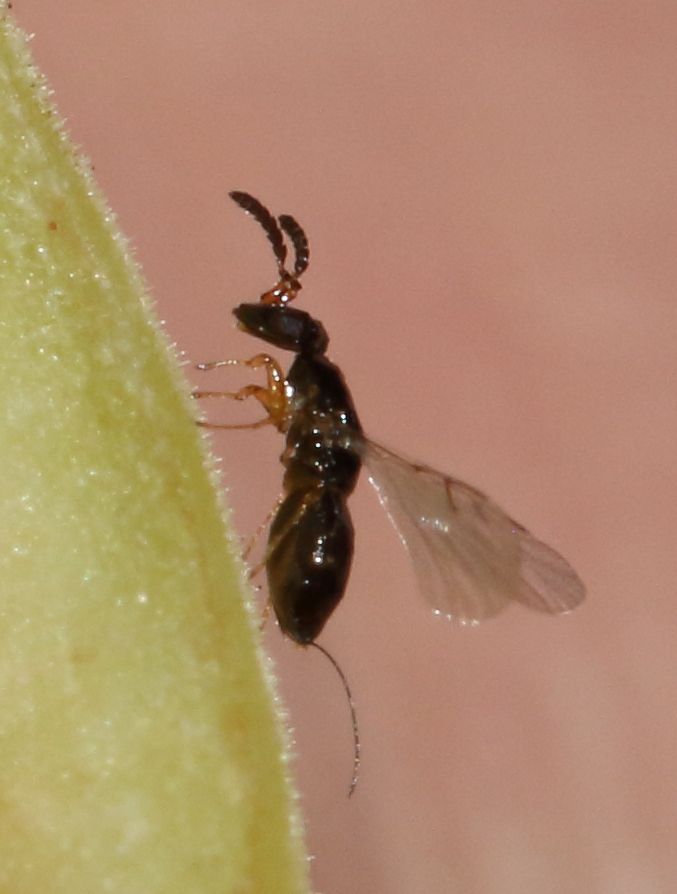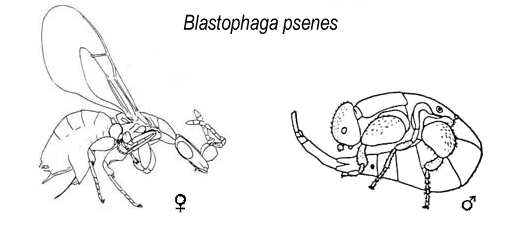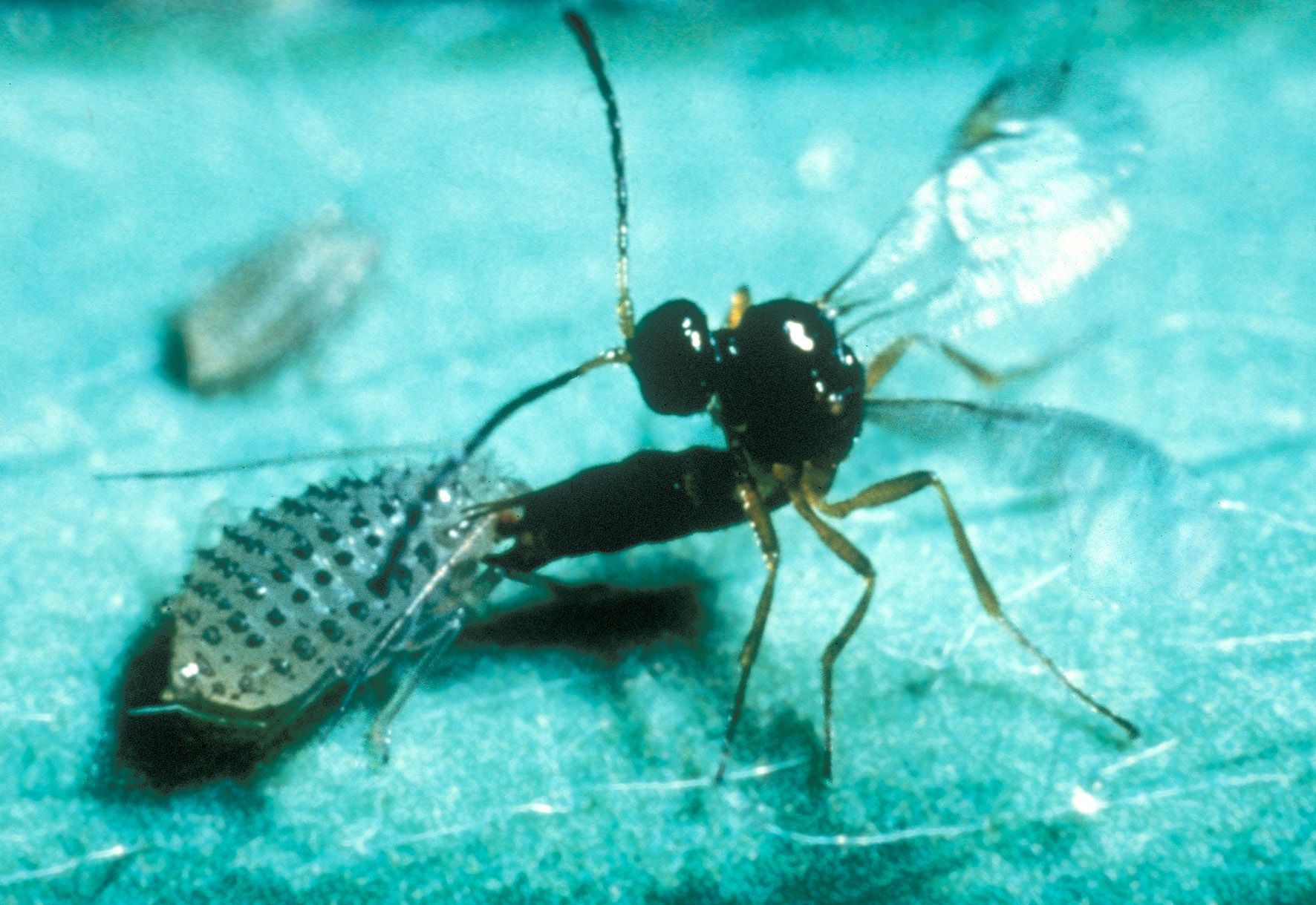|
Chalcidoidea
Chalcid wasps (, , for their metallic colour) are insects within the superfamily Chalcidoidea, part of the order Hymenoptera. The superfamily contains some 22,500 known species, and an estimated total diversity of more than 500,000 species, meaning the vast majority have yet to be discovered and described. The name "chalcid" is often confused with the name "chalcidid", though the latter refers strictly to one constituent family, the Chalcididae, rather than the superfamily as a whole; accordingly, most recent publications (e.g.,) use the name "chalcidoid" when referring to members of the superfamily. Most chalcid wasps are parasitoids of other insects, though other life styles are known, with the herbivorous fig wasps acting as pollinators. Various species are used as biological pest control agents or in scientific research. Description Chalcidoids are generally small wasps, averaging 1.5 mm in length and usually being less than 3 mm. The body is often metallic in colour ... [...More Info...] [...Related Items...] OR: [Wikipedia] [Google] [Baidu] |
Fairyfly
The Mymaridae, commonly known as fairyflies or fairy wasps, are a family (biology), family of chalcid wasp, chalcidoid wasps found in temperate, subtropical, and tropical regions throughout the world. The family contains around 100 genera with 1,400 species. Fairyflies are very tiny insects, like most Chalcid wasp, chalcidoid wasps, mostly ranging from long. They include the Dicopomorpha echmepterygis, world's smallest known insect, with a body length of only , and the Kikiki, smallest known flying insect, only long. They usually have nonmetallic black, brown, or yellow bodies. The antennae of the females are distinctively tipped by club-like segments, while male antennae are thread-like. Their wings are usually slender and possess long bristles, giving them a hairy or feathery appearance, although some species may have greatly reduced stubby wings or lack wings altogether. These unusual-looking wings work by utilizing Drag (physics), air resistance—which at their minuscule si ... [...More Info...] [...Related Items...] OR: [Wikipedia] [Google] [Baidu] |
Agaonidae
The family Agaonidae is a group of pollinating fig wasps. They spend their larval stage inside the fruits of Ficus, figs. The pollinating wasps (Agaoninae, Kradibiinae, and Tetrapusiinae) are the mutualism (biology), mutualistic partners of the Ficus, fig trees. Extinct forms from the Eocene and Miocene are nearly identical to modern forms, suggesting that the niche has been stable over geologic time. Females emerge from ripe figs and fly to another fig tree with developing Syconium, syconia (which contain the flowers). They enter the syconium via the ostiole, pollinate the flowers, and lay their eggs in some of the ovules. The ovules containing eggs develop into galls that support the growth of the wasp larvae. Prior to the final ripening of the fig, wingless males emerge from the galls they developed in. The males enter the galls of their winged sibling females, mate with them and die within the fruit. The newly hatched females then make their way out of the fruit continuing th ... [...More Info...] [...Related Items...] OR: [Wikipedia] [Google] [Baidu] |
Fig Wasp
Fig wasps are wasps of the superfamily Chalcidoidea which spend their larval stage inside fig syconia. Some are pollinators but others simply feed off the plant. The non-pollinators belong to several groups within the superfamily Chalcidoidea, while the pollinators are in the family Agaonidae. Pollinating fig wasps are all gall-makers, while non-pollinating fig wasps either make their own galls or usurp the galls of other fig wasps. The lifestyles of these fig wasps rely on the fruit of fig trees to reproduce, with pollinating fig wasps acting as mutualists, and non-pollinating fig wasps as parasitoids. History Aristotle recorded in his '' History of Animals'' that the fruits of the wild fig (the caprifig) contain ''psenes'' (fig wasps); these begin life as grubs (larvae), and the adult ''psen'' splits its "skin" (pupa) and flies out of the fig to find and enter a cultivated fig, saving it from dropping. He believed that the ''psen'' was generated spontaneously; he did no ... [...More Info...] [...Related Items...] OR: [Wikipedia] [Google] [Baidu] |
Chalcididae
The Chalcididae are a moderate-sized family within the Chalcidoidea, composed mostly of parasitoids and a few hyperparasitoids. The family is apparently polyphyletic, though the different subfamilies may each be monophyletic, and some may be elevated to family status in the near future. As presently defined, there are over 85 genera and over 1460 species worldwide. They are often black with yellow, red, or white markings, rarely brilliantly metallic, with a robust mesosoma The mesosoma is the middle part of the body, or tagma, of arthropods whose body is composed of three parts, the other two being the prosoma and the metasoma. It bears the legs, and, in the case of winged insects, the wings. Wasps, bees and a ... and very strong sculpturing. The hind femora are often greatly enlarged, with a row of teeth or serrations along the lower margin. One of the more remarkable uses of the muscular hind legs is the species ''Lasiochalcidia igiliensis'', which attacks the predat ... [...More Info...] [...Related Items...] OR: [Wikipedia] [Google] [Baidu] |
Melanosomellidae
Melanosomellidae is a family of parasitic wasps in the superfamily Chalcidoidea Chalcid wasps (, , for their metallic colour) are insects within the superfamily Chalcidoidea, part of the order Hymenoptera. The superfamily contains some 22,500 known species, and an estimated total diversity of more than 500,000 species, m ...; it includes 31 described genera, which are mostly found the southern hemisphere. Although the biology of most of these wasps is unknown, the larvae and pupae of some species develop in leaf galls or stem galls on various trees. Genera This family contains the following genera: * '' Aditrochus'' * '' Aeschylia'' * '' Alloderma'' * '' Alyxiaphagus'' * '' Australicesa'' * '' Brachyscelidiphaga'' * '' Encyrtocephalus'' * '' Epelatus'' * '' Espinosa'' * '' Eurytomomma'' * '' Hansonita'' * '' Hubena'' * '' Indoclava'' * '' Krivena'' * '' Lincolna'' * '' Lisseurytoma'' * '' Mayrellus'' * '' Megamelanosoma'' * '' Nambouria'' * '' Neochalc ... [...More Info...] [...Related Items...] OR: [Wikipedia] [Google] [Baidu] |
Eurytomidae
The Eurytomidae are a family within the superfamily Chalcidoidea. Unlike most chalcidoids, the larvae of many are phytophagous (feeding in stems, seeds, or galls), while others are more typical parasitoids, though even then the hosts are usually found within plant tissues. Some species of eurytomids are unusual in the sense that they are parasitoids of spider eggs. Females of this group are idiobionts that probe through the thin silk of spider egg sacs and oviposit into individual spider eggs that are clustered within the sacs. They are found throughout the world in virtually all habitats, and a few are considered pests. They tend to be dull and not metallic, and heavily punctured, with very thick, collar-like pronota. Taxa , Eurytomid genera include: Buresiinae Lotfalizadeh et al., 2007 * '' Buresium'' * '' Macrorileya'' Eurytominae * '' Aiolomorphus'' * '' Aranedra'' * '' Austrodecatoma'' * '' Ausystole'' * '' Axanthosoma'' * '' Axanthosomella'' * ''Axima'' ... [...More Info...] [...Related Items...] OR: [Wikipedia] [Google] [Baidu] |
Doddifoenus Wallacei
''Doddifoenus wallacei'' is a species of wasp in the family Pelecinellidae. It is the longest known species in the superfamily Chalcidoidea; the female has a length (including ovipositor) of up to 41.4 mm, and its body length ranges from 17.1 to 19.6 mm. The species is diurnal and is known only from Thailand Thailand, officially the Kingdom of Thailand and historically known as Siam (the official name until 1939), is a country in Southeast Asia on the Mainland Southeast Asia, Indochinese Peninsula. With a population of almost 66 million, it spa .... References Chalcidoidea Insects of Thailand Insects described in 2009 {{Chalcidoidea-stub ... [...More Info...] [...Related Items...] OR: [Wikipedia] [Google] [Baidu] |
Eulophidae
The Eulophidae is a large family of hymenopteran insects, with over 4,300 described species in some 300 genera. The family includes the genus '' Elasmus'', which used to be treated as a separate family, "Elasmidae", and is now treated as a subfamily of Eulophidae. These minute insects are challenging to study, as they deteriorate rapidly after death unless extreme care is taken (e.g., preservation in ethanol), making identification of most museum specimens difficult. The larvae of very few species feed on plants, but the majority are primary parasitoids on a huge range of arthropods at all stages of development. They are exceptional in that they are one of two hymenopteran families with some species that are known to parasitize thrips Thrips (Order (biology) , order Thysanoptera) are minute (mostly long or less), slender insects with fringed wings and unique asymmetrical mouthparts. Entomologists have species description , described approximately 7,700 species. They fly on ... [...More Info...] [...Related Items...] OR: [Wikipedia] [Google] [Baidu] |
Torymus Female
''Torymus'' is a genus of chalcid wasps from the family Torymidae, and there are more than 400 spp. worldwide. It was named by the Swedish naturalist Johan Wilhelm Dalman in 1820. Most species are ectoparasitoids of gall forming insects, usually gall wasps Gall wasps, also wikt:gallfly#Usage notes, traditionally called gallflies, are hymenopterans of the family Cynipidae in the wasp superfamily Cynipoidea. Their common name comes from the galls they induce on plants for larval development. About 1 ... and gall midges. See also * List of Torymus species References External links Bugguide.net. Genus Torymus Hymenoptera genera Taxa named by Johan Wilhelm Dalman Chalcidoidea Taxa described in 1820 Torymidae {{chalcidoidea-stub ... [...More Info...] [...Related Items...] OR: [Wikipedia] [Google] [Baidu] |
Omphale Cornula
''Omphale cornula'' is a species of wasp in the family Eulophidae. It is known from western Europe (France, Netherlands, United Kingdom, Denmark, and Sweden). The body length is in males and in females. The host is unknown but other ''Omphale'' are parasitoids of gall midges (Cecidomyiidae Cecidomyiidae is a family of diptera, flies known as gall midges or gall gnats. As the name implies, the larvae of most gall midges feed within plant tissue, creating abnormal plant growths called galls. Cecidomyiidae are very fragile small in ...). References Eulophidae Hymenoptera of Europe Insects described in 2012 {{Vespidae-stub ... [...More Info...] [...Related Items...] OR: [Wikipedia] [Google] [Baidu] |
Parasitoid
In evolutionary ecology, a parasitoid is an organism that lives in close association with its host (biology), host at the host's expense, eventually resulting in the death of the host. Parasitoidism is one of six major evolutionarily stable strategy, evolutionary strategies within parasitism, distinguished by the fatal prognosis for the host, which makes the strategy close to predation. Among parasitoids, strategies range from living inside the host (''endoparasitism''), allowing it to continue growing before emerging as an adult, to Paralysis, paralysing the host and living outside it (''ectoparasitism''). Hosts can include other parasitoids, resulting in hyperparasitism; in the case of oak galls, up to five levels of parasitism are possible. Some parasitoids Behavior-altering parasite, influence their host's behaviour in ways that favour the propagation of the parasitoid. Parasitoids are found in a variety of Taxon, taxa across the insect superorder Endopterygota, whose compl ... [...More Info...] [...Related Items...] OR: [Wikipedia] [Google] [Baidu] |
Dicopomorpha Echmepterygis
''Dicopomorpha echmepterygis'' is the smallest known insect and a species of parasitoid wasp of the family Mymaridae, which exhibits strong sexual dimorphism. The males are blind, apterous, and their body length is only 40% that of females. With a body length averaging 186 μm (for 8 specimens measured, which ranged from 139 to 240 μm), males of ''D. echmepterygis'' have the shortest body length of all known insects (smaller than certain species of ''Paramecium'', amoeba, and shorter than certain bacteria, ''Thiomargarita magnifica'', all of which are single-celled organisms). The measured body length of a female was 550 μm. ''Dicopomorpha echmepterygis'' males have relatively long legs and are dull grayish brown, with small heads that lack compound eyes, and unsegmented antennae. Females, however, have entirely black bodies with dusky brown legs and antennae. The antennae are twice as long as for males, and females have fully-functional wings that are narrowed slightly throug ... [...More Info...] [...Related Items...] OR: [Wikipedia] [Google] [Baidu] |





